Walking the Rip-Off - Heygate & Aylesbury Estates
Heygate & Aylesbury Estates, Southwark. Sun 29 April 2012
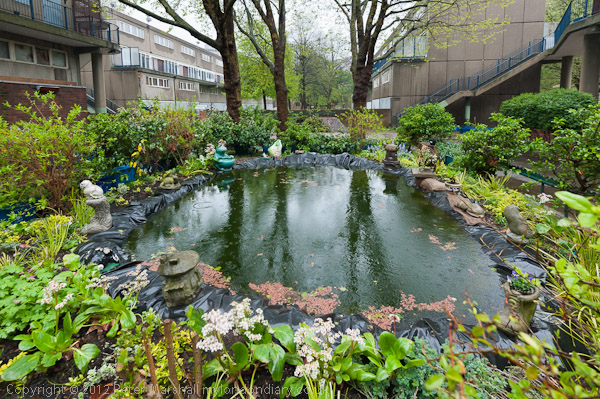
Community gardens on Heygate Estate
more pictures
London is in housing crisis, with virtually no affordable housing for anyone except the rich. For those dependent on housing benefit the problem has increased drastically with the government's announcement of a cap on this benefit at a level that is frankly ludicrous for almost all of London.
Social housing has been under attack at least since the Thatcher era, with much being sold off to tenants or passed over to housing associations. Government policies have prevented or discouraged the replacement of social housing stocks and the private sector has had its restrictions removed, with tenants losing most of the protection they once had.
Part of the problem is undoubtedly that those in government responsible have no real idea of the actual state and working of the housing market at the lower end - as they demonstrate when questioned on radio and TV, making ridiculous statements about the availability of property at reasonable rents. For example they seem blissfully unaware that many private landlords actually refuse to rent to people on housing benefit.
Of course there are no problems for the rich; plenty of million pound or more properties and some huge estates in the glossy pages of Country Life for only £4m or so.
A few days ago, one London Borough - Newham - was writing to housing associations all around the country, trying to find some who would be willing to house people from Newham - away from any family, friends, neighbours and jobs they may have in Newham or the surrounding area. Yet at the same time, Newham is removing tenants as fast as it can from an estate on the fringe of the Olympic Park, intending to demolish the council houses and three tower blocks there. It claims that it would be too expensive to renovate them to decent standards - a claim almost certainly untrue for the houses and probably for the blocks. Redevelopment will mean more than 500 council housing units being replaced by less than 80 - or possibly none if plans for a new university campus on the site come to fruition.
But a far bigger scandal has already occured in Southwark, with the Heygate estate. The 1300 homes here have almost all been lying empty since 2008 and are planned to be demolished in 2015. Most were sound and could have been refurbished. A council-commissioned survey in the late 1990s concluded that this was not a problem estate and found that most people were happy living there - despite considerable neglect of the estate by the council. Completed in 1974 it was a well-designed and constructed estate in the brutalist style of its time, and with proper maintainence and relatively minor refurbishment work much or all of it could have certainly provided decent living into the middle of the 21st century.
The estate was to be sold to a developer at a knockdown price of £20m, almost certainly less than one tenth of the market value. The planned development lacks any of the better features of the existing estate. It will of course provide a greater rent income, but not the social housing which is desperately needed. Many of the leaseholders were pressured into accepting ludicrously low valuations for their properties - such as £66,300 for a 3 bed maisonette - roughly a quarter of value of the property in Southwark.
If I understand it correctly, the demolition and replacement by inferior buildings which is promoted to us as 'regeneration' is driven by two things. The possibility for profit by developers and overseas investors who will buy the flats as investment properties to lease at high rents, and the removal of debts from the council books by selling off publicly owned assets.
Heygate was a large estate, but just to its south is the Aylesbury Estate, roughly twice the size, built between 1963-77. An estate with a worse reputation than the Heygate (though much of the bad reputation of both comes from a deliberate campaign of demonisation and rehousing of problem families in them.) Southwark is intending to repeat the serious mistakes over the Heygate there - with some slight variations.
Southwark Council claims to carry out 'consultations' with tenants over regeneration, but in fact employs public relations firms to give the appearance of consultation to produce what many residents feel to be glossy misrepresentations of their views.
Four properties on the Heygate estate remain occupied by lease-holders, and some of the large area of open space is still being used as urban gardens by current and former residents and others. I went on 'Walking the Rip-Off' organised by Southwark Notes Archive Group and Aylesbury Tenants First (and here) which started in the "community gardening projects of Heygate" and went on "to the Aylesbury for a look and learn around the massive site." It was an interesting and illuminating experience. There were around 35 people altogether despite the rain and a terrible weather forecast, and fortunately it slackened off and the sun actually came out.
As well as viewing the gardens and the exteriors of many of the blocks on both estates, we were also able to see the interiors of flats on both estates. It was perhaps surprising to find that Southwark had not carried out some of the modernisation that I would have expected - such as the installation of double-glazing - which I would take for granted in modern properties, but otherwise they seemed very-well designed units - and you can see two of those we visited - each given a very different character by their occupants - and several others on the Aylesbury tenants blog. The Southwark Notes site gives a remarkable view of the history of the estate and of the 'regeneration' process.
I took a few pictures on these estates back in the 1980s and 90s when I was working in the area and you can see the pictures I took last year in Heygate Estate Scandal and Heygate Panoramas on this site.
On my way home I took a few pictures around the Strata Tower (sometimes called
the Razor) at the south of the Elephant shopping centre. Like the proposed
new developments it includes a small proportion of so-called "affordable"
housing. I was told earlier that this has its own separate entrance and lift,
away from the main entrance for the other tenants. If true, I find this kind
of social apartheid appalling.
more pictures
Support For Palestinian Hunger Strike
Downing St, London, Sat 28 April 2012
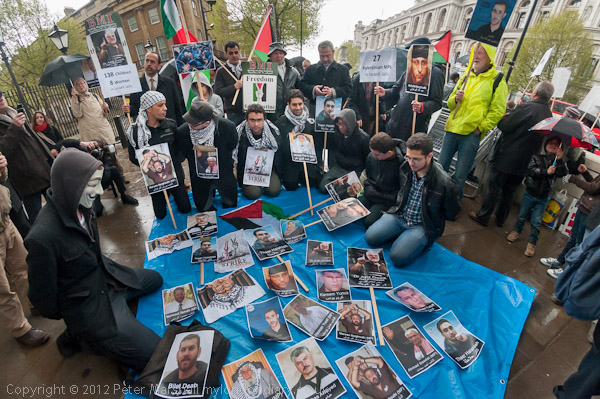
Protesters posed with hands tied behind their backs as prisoners
more pictures
Around a hundred protesters came to Downing St to show their support for the more than 1200 Palestinian prisoners in Israeli jails on hunger strike against administrative detention and other issues.
Palestinians held in Israeli jails include 27 Palestinian MPs, 8 women and 138 children. Despite the protest being called at the last minute, around a hundred people turned up and protested in the light rain on the pavement opposite Downing St.
A number of them had their hands tied behind their backs and posed kneeling with posters and placards for photographs. The protest organisers state that the sraeli Prison Service (IPS) has escalated its punishments of hunger striking prisoners including confiscation of personal belongings prison transfers and the use of solitary confinement and denial of family and lawyer visits. They say that laywers have been denied access to all hunger striking prisoners, and that in Ashkelon and Nafha prisons they are being denied salt in the water they are drinking, raising serious health concerns.
Among those held in jail are those in administrative detention, held without any charge or trial. Their numbers have risen steadily over the past 18 months are are currently thought to be around 320.
There are plans for a series of protests at Downing St every evening next
week calling for the release of prisoners and an end to their mistreatment.
more pictures
Big Ride for Safe Cycling
Park Lane -Temple, London. Sat 28 April 2012

Go Dutch - and provide streets that are safe for cyclists and pedestrians
in London
more pictures
The Big Ride, London's largest ever cycle protest, organised by the London Cycling Campaign called on the mayoral candidates to make London more liveable for everyone by making our streets as safe and inviting for cycling as they are in Holland.
It was impossible to count the number of cyclists of all ages and sizes who took to London's streets to call on the next London mayor to show their commitent to making London's streets safer and healthier by encouraging walking and cycling. Some estimates put the number of riders at around 10,000, and at the start of the ride through central London, cyclists filled Park Lane and more were still arriving and later the ride more than filled the length of Whitehall.
Despite the rain which kept on steadily through the ride, cyclists came and called for London to "Go Dutch", and for the next mayor to select three high-profile locations for Dutch-style cycling infrastructure, which encourages cycling and walking. And the campaign has been a great success, with all the major mayoral candidates signing up to implement this if they are elected. Green Party candidate Jenny Jones, long a forceful campaigner for a better deal for cyclists was on the ride, though I didn't see any others.
It was a family-friendly bike ride just days before the mayoral election along a four-mile route through central London with police clearing the traffic and marshals controlling crossings along the route.
LCC's chief executive Ashok Sinha said:
"The Big Ride is our best chance to show the next mayor we're serious about redesigning our streets to make them safer for everyone.
"Some of the mayoral manifestos show very weak commitments to cycling, so every person who comes to the Big Ride can help push safer cycling up the next mayoral agenda.
"Please come and bring your friends and family to this fabulous day out with a purpose."
From its start near Hyde Park Corner, the ride went past Piccadilly Circus,
Trafalgar Square and the Houses of Parliament, ending up at a large balloon
arch across the road near Blackfriars. Many of those taking part dressed up
for the event and there were some weird and wonderful machines taking part.
For many it was a family day out and there were some very young participants
both in trailers and on various small bicycles among the crowd.
more pictures
Workers Memorial Day
Tower Hill, London. Sat 28 April 2012
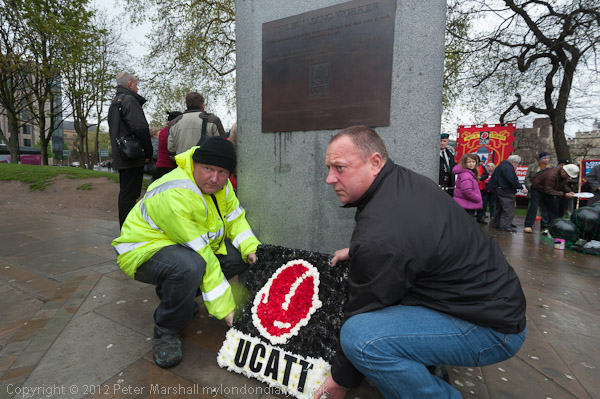
The UCATT wreath is laid at the Building Worker statue
more pictures
Around a hundred trade unionists and pensioners met at the statue of the Building Worker at Tower Hill on Workers Memorial Day to remember those killed and maimed at work, laying wreaths and releasing black balloons.
The London ceremony was one of many held around the world, including around 70 in towns and cities across the UK - including five in London. The message of all af them was "Remember the dead – Fight for the living."
20,000 people in the UK die every year as a result of their work acoording to government and HSE figures - though many campaigners believe the true figure is at least twice this.
Most accidents at work are not accidents, but the predictable results of cutting corners on safety. Where workplaces have union health and safety reps and safety committees to aid in ensuring proper safety practices the number of serious injuries at work is halved.
A huge number - 1.9 million working age people - in Great Britain are living with injuries caused or made worse by their jobs - equivalent at the TUC point out to the populations of Edinburgh, Liverpool, Cardiff, Newcastle, Portsmouth and Blackpool combined.
Britain ranks poorly for Health and Safety compared to other OECD industrialised countries - 20th out of 34. Despite this the government is cutting the funding of the Health and Safety Executive responsible for inspecting and enforcing workplace safety by 35% over the next three years. Already the number of workplace safety inspections have fallen by 50% of the past 10 years - and the number of prosecutions of employers for breaches of safety at work has dropped by the same amount. Employers organisations constantly lobby government to cut regulations and cut enforcement and the result will be more 'accidents' more injuries and more deaths.
Workers Memorial Day began in Canada in 1984, and April 28 was chosen as it was the anniversary of their 1914 Workers Compensation Act. It was recognised in the US in 1989, came to the UK in 1992 and was recognised by the Scottish TUC in 1983, the TUC in 1999 and the Health and Safety Executive in 2000. In 2002 it was adopted by the UN as the World Day for Safety and Health at Work and it is now observed in many countries around the world. It is also known as the International Commemoration Day for Dead and Injured.
Among the speakers on a damp morning were Jerry Swain from UCATT - the construction industry is the most dangerous in Britain, and there were 50 black balloons to represent the previous year's deaths on building sites. Tony O'Brien, secretary of the Construction Safety Campaign which has done so much to highlight the problem and organised this event also spoke, as well as Barry Todman, chair of the London region of the National Pensioners Convention. The international nature of the problem - and the event - was brought home by a short contribution from Sanjay, one of the survivors of the world's largest environmental disaster in Bhopal, India in 1984 which is thought to have resulted in around 11,000 deaths and to have injured more than half a million people, and whose affects are still severe. Union Carbide, the owners of the plant, are now owned by Dow Chemical, and their sponsorship of the London Olympics has caused both controversy and protests.
The final speaker was Simon Hester, the Prospect union rep for London's HSE inspectors, who made clear the way that cuts and government policy have seriously undermined the ability of the HSE to do its vital work in making workplaces safe.
As TUC General Secretary Brendan Barber said in his press release for Workers Memorial Day:
'Sensible employers who are happy to work closely with unions improving safety and occupational health at work don't see safety regulation as an intrusive burden. But rogue employers, who are happy to cut corners and take risks with their employees' safety, do.
'It's these reckless employers that we need to target and the government's
rhetoric will only encourage yet more of them to think they can get away with
unsafe workplaces - without fear of ever getting a visit from the HSE or their
local council.'
Wreaths were laid at the statue of the building worker, and after a minute's
silence the black balloons - one for each building worker killed at work in
the last year - were released. The event ended with a bagpiper playing a lament.
more pictures
Embassy Protest Supports 'Pussy Riot'
Russian Embassy, Kensington, London. Monday 23 April 2012

Woman in pink hood holds Pussy Riot placard brought
from Moscow in protest opposite the embassy
more pictures
Protesters gathered close the the Russian Embassy to call for the release of three women remanded in jail in Russia who are alleged to have performed a punk-prayer 'Virgin Mary, Send Putin Away' in a Moscow cathedral in February.
The anonymous Russian Feminist Punk band 'Pussy Riot' was formed in Oct 2011 to campaign for civil and human rights and to call for an end to the Putin regime. They perform wearing colourful skirts, leggings and hoods to protect their identity and have gained wide publicity by performances in public places including Moscow's Red Square.
On 21 Feb 2012, five members of the group entered Christ the Saviour cathedral in Moscow and performed a 'punk-prayer' at the alter with the chorus "Virgin Mary, Become Feminist / Virgin Mary, Send Putin Away" for almost a minute before guards ejected them. A video including footage inside the cathedral went viral on YouTube later that day. As well as attacking Putin, the song also mocked the Patriach of the Russian Orthodox Church
The Church, which operates closely with the Russian authorities decided to press legal action against the band for 'hooliganism', which carries a maximum punishment of seven years jail.
Two women, Maria Alyokhina and Nadezhda Tolokonnikova, were arrested on 4 March, and and held in jail. They went on hunger strike and exercised their right to silence under 51 article of Russian Constitution. An appeal for them to be freed was rejected on 14 March and a third woman who had been called as a witness, Ekaterina Samusevich, was also arrested.
The Russian Orthodox Church issued a statement on March 19 calling for the full force of the law to be used against those who took part in the performance and also "its organizers and its possible masterminds" and dismissing the calls from some in the church to forgive the "blasphemous women."
The three women appeared in court on April 19, and were remanded in custody until June 24. Around a hundred protesters gathered outside the court, and around 30 of them who expressed support for Pussy Riot were taken away in police vans. Russian TV later reported these protesters had been released.
There has been widespread support for the jailed Pussy Riot members, who deny being among the five who performed in the cathedral from human rights activists in Russia and around the world. Amnesty International has declared the activists to be 'prisoners of conscience' and has launched an international campaign to free the activists.
Around a hundred protesters, including a number of Russians and Climate Rush supporters came to protest on a dull damp evening at London's Russian embassy, one of many international protests calling for the release of the Pussy Riot members. At first a group gathered on the pavement outside the only embassy building on a public road where they donned hoods and scarves to cover their faces like members of Pussy Riot, but police soon persuaded the protesters to move into the pen on the opposite side of the road facing the building.
Here they displayed banners and placards calling for the three members of Pussy Riot held in jail to be freed, and chanted for them to be released and for Putin to go. There were a few short speeches, including a bilingual Russian-English address, and a first-hand report from Russia on both the court appearance of the three last Thursday and a meeting held by the Russian Orthodox Church to condemn the actions. This had suggested that the draconian joint approach to the 'hooliganism' by Pussy Riot was justified as they three women arrested had shown no signs of remorse or apology for their actions in the Cathedral. The three women, although admitting they are members of Pussy Riot claim they were not among the five members who gatecrashed and performed there.
One of the placards on display had been brought back today from Moscow, where it had been produced by Pussy Riot. It showed a member of Pussy Riot in blue hood and leggings, red dress and lively spotted blue boots nailed to a cross, with a sign above her reading 'Pussy Riot' and at the bottom a Russian slogan calling for Freedom for Pussy Riot.
The Russian protesters had brought a large banner with 'Free Pussy Riot'
on it, to which they attached large photographs of the three jailed women.
more pictures
Olympic Course Day 2
Hackney Wick, London. Sun 22 April 2012
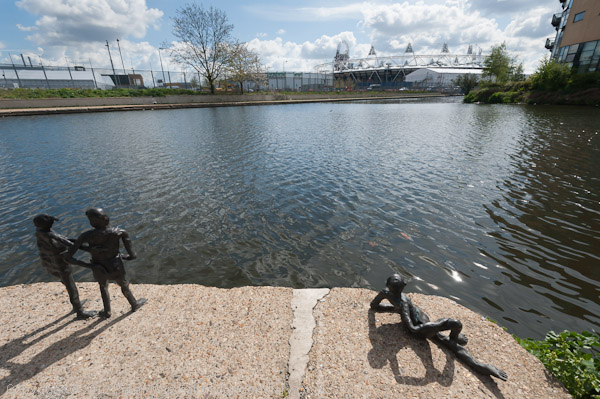
Watching the Olympic site from the junction with the Hertford Union at Hackney
Wick
more pictures
We met on Sunday morning at Pudding Mill Lane station and walked up the Greenway to Hackney Wick, through Fish Island to White Posts Lane. i'd arrived half an hour or so early and had taken a couple of panoramas before the others arrived. It was by then getting a little late, so after a short while there went across the bridge over the navigation and back down to Old Ford Lock. Because the path up to the Greenway beyond there is closed we then had to go across the lock and walk to the start of the Greenway to make our way back to the View Tube.
After a brief lunch break - when I again made a couple of panoramas - we
looked at and talked about the work we had each taken on the course, although
the View Tube's expensive touch screen was far too dim to see the work properly
as the classroom is too brightly lit from the windows which have no blinds.
The lack of decent viewing facilities was for me the only real problem with
the course.
more pictures
Olympic Course Day 1
Stratford, London. Sat 21 April 2012
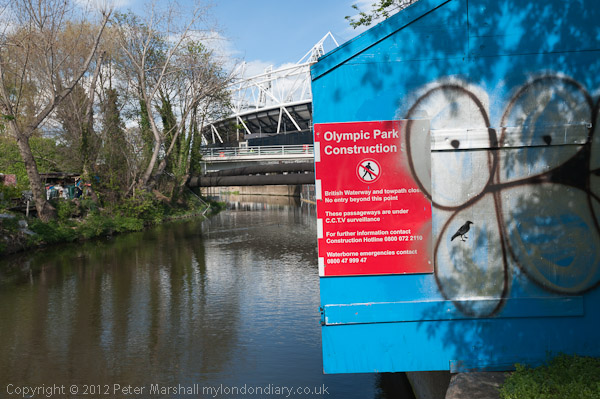
The Old River Lea with new bridge, stadium and closed path
more pictures
It's getting close to our last chance to see much of the Olympic site before the games, with the Greenway closing in Hackney Wick at the end of the month and the short section from Pudding Mill Lane giving access to the View Tube from mid-May. And on 3 July the towpath along the Lea Navigation will be closed too, along the length of the Olympic site. The navigation will be more or less closed to boats too, with passage only possible during an early morning or evening window for those who have booked at least a week earlier.
So the workshop I was leading at the View Tube this weekend was really one of the last chances to see the area before the Games. The paths will reopen at the end of September, though those affected by Crossrail will be there until 2014, and I doubt the public will ever get back the same kind of access to the area we enjoyed before the Olympic bid. And of course much of what made the area worth visiting has been destroyed.
These pictures are from the two walks around the area I led on Saturday,
and although I was really there to facilitate the work of those on the course
I did manage to spend a little time making my own work. On the first walk
we went along the southern edge of the site and into Stratford Westfield and
up to the John Lewis viewing area, and then, after a short break for lunch
in which I made some panoramas from around the View Tube, along the Greenway,
into Fish Island, across Old Ford lock, down the towpath to Bow Flyover and
then to Pudding Mill Lane station.
more pictures
Climate Rush Spring Clean London's Air
Smith Square -Parliament Square, London. Thur 19 April 2012
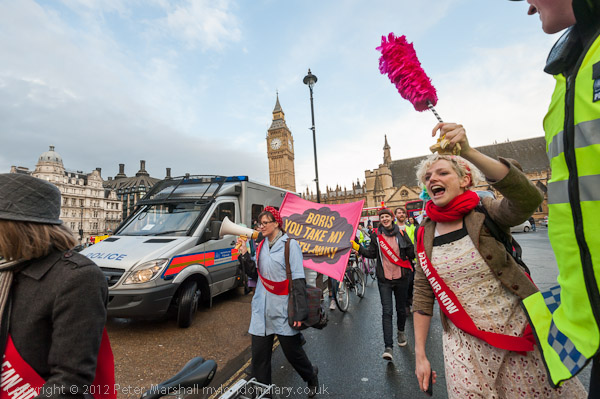
Marching around Parliament Square
more pictures
Eco-activist group Climate Rush protested against London's filthy air in a cycle-based protest around Westminster, ending in Parliament Square, calling for a change of Mayor to improve life in London.
Anyone who like me regularly works on London's streets will not need telling about the poor air quality which makes my eyes sting after a day's work and occasionally leaves me coughing. The UK has consistently failed to meet the EU limits which became law in the UK under the Air Quality Standards Regulations 2010. Although there has been some progress towards meeing the limits on particulate matter (PM10) in London, activists complain that this has at least partly been acheived not by actually cutting emissions but simply by gluing them down to the surface in the areas around the monitoring stations. This use of pollution suppressants around these stations as a central part of Mayor Boris Johnson's Air Quality Strategy has been described as "public health fraud on an industrial scale" and it is hard to see it in any other light.
The Clean Air Acts got rid of much of the visible pollution, but the most dangerous pollutants such as nitrogen oxides, are invisible, and London levels are well above the EU limits and regularly exceed double the World Health Organisation's legal limits. The UK risks fines from the EU of up to £300 million for failing to ensure proper air quality.
But what matters much more than fines is the effect that these fumes - largely from petrol and diesel driven motor vehicles - have on those who live or work in London. As Climate Rush point out the Governments own figures show that "air pollution leads to the early deaths of up to 50,000 people every year in the UK, and in London can reduce our lives by up to nine years, and causes more deaths than passive smoking, obesity and road traffic accidents." In London alone, every year more than 4000 die early as a result of the poor air quality, a major and preventable health risk.
Most of these premature deaths come from respiratory and cardiovascular disease. Asthma UK state that two thirds of people with Asthma report that traffic fumes make their asthma worse and almost half of sufferers are discouraged from walking or shopping in congested areas.
The high levels of pollution on our streets affect some groups in society disproportionately, particularly the poor - who live closer to busy roads than the more affluent, young children because pollution levels are higher closer to ground level and cyclists, whose activity leads them to breathe large quantities of the polluting air.
This was a cycle-based protest both because cyclists are affected more than others by the pollution, but also because cycling is one of the ways that we can cut pollution on our streets. The 'Boris bikes' - originated by Ken Livingstone - are a small step, but what we need are far more radical policies to encourage cycling in London by making it safer by designing roads to encourage and prioritise cycling over motorised vehicles. At the moment the opposite happens, with TfL being told to design junctions such as that at King's Cross without any consideration for cyclists (or indeed much for pedestrians, another less polluting form of transport.)
The speeches at the start of the protest in Smith Square also called for more affordable and accessible public transport - an area where London lags behind other cities such as Paris, and the implementation of an inner low emission zone in London, with fewer cars and less polluting vehicles. The campaigners also oppose airport expansion, both because of the emissions which lower air quality in the capital, but also because Heathrow creates high levels of pollution around it due to the traffic it attracts.
As well as health issues, the pollution from traffic on the ground and in the air is a major contributer to climate change through emissions of carbon, carbon dioxide, methane and other greenhouse gases.
A torrential downpour in the three-quarters of an hour before the protest began doubtless put some cyclists off of making the ride to Smith Square for the start of the protest, although fortunately the rain stopped exactly at the time the protest began, and held off until it was over.
The protesters met outside the offices of DEFRA, and there was a small incident when the security there tried to prevent a collegue filming the outside of their building. He told them that he had the right to film in a public place, and called over some of the police officers around who talked to him and the security men and who after a short discussion with both videographer and security confirmed to them that he was allowed to film what he wanted.
Before the march set off there were a couple of speeches, one from a London Green Party candidate who had stepped in at the last minute as Jenny Jones, the Green Mayoral candidate unfortunately had to leave as the protest was starting, who was a fine replacement. The protest had been announced as 'Spring Clean - Because London's Air is Filthy', and some of those attending had come dressed as cleaners, with yellow rubber gloves and carrying feather dusters as well as wearing Climate Rush sashes. Tamsin Omond was at the front of the march, leading a banner 'Boris You Take My Breath Away' and the marchers were chanting that for cleaner air we needed to change our Mayor as Boris Johnson has shown he is unprepared to take any serious steps to improve air quality and has simply tried to hide the problems. They marched up Millbank and around Parliament Square before stopping and cleaning up the area of pavement and air close to the statue of Churchill in front of Big Ben with their feather dusters and declaring it London's first true Clean Air Zone.
Disabled Activists Block Trafalgar Square
London. Wednesday 18 April 2012
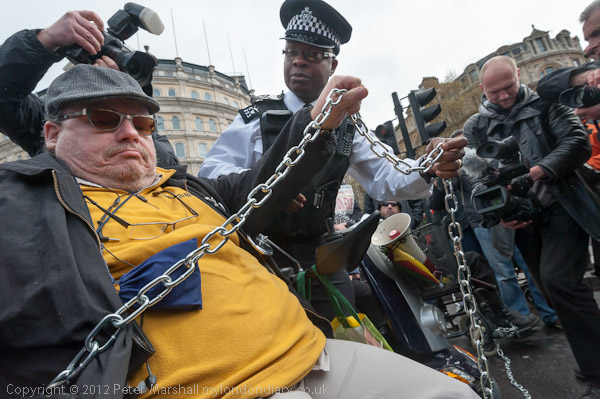
Protesters chained their wheelchairs across the road
at Trafalgar Square
more pictures
Disabled activists and supporters chained wheelchairs across the road at Trafalgar Square in protest against benefits cuts, unfair fitness assessments, loss of employment opportunities, worsening health care and other attacks on the disabled.
The protest led by DPAC (Disabled People Against Cuts) and UK Uncut reflected the desperation felt by many disabled people who have seen the repressive measures started under the Labour government to cut welfare benefits made even more stringent under the coalition. In particular the use of tests known to be unfit for purpose adminstered badly by Atos has resulted in many disabled people who are unable to work - including many terminal cancer patients - being passed as fit and losing the benefits that they need for any decent life (and has led to some committing suicide.) And while more and more are being told they are fit to work, the government has cut Remploy, an organisation that enabled many who were disabled to work, at a time when even the fittest have great difficulty in finding jobs. Added to this are the general cuts in social care provision and public services which disproportionally impact on the disabled, and the privatisation of the NHS which will reduce the level of provision for the disabled.
A DPAC organiser stated "We have no more to give. Our benefits, social care and support funding are fast disappearing. Hundreds of disabled people are losing their jobs. Pensioners, disabled people, carers and workers pay the costs of tax breaks for the highest earners. The health service is being carved up and sold through the back door, and large multinationals with profits of billions take on disabled and young people as free labour."
The protesters gathered in Leicester Square, and then marched down the Charing Cross Road. Police stopped them on the road and tried to insist that they march on the pavement, but they refused to do so, as it was too narrow, too crowded and had too many kerbs and obstructions to be practical for wheelchair and invalid tricycle users. Eventually when the protesters said they were only going to Trafalgar Square the police agreed to let them continue on the road - the police intervention had already resulted in a longer traffic hold-up than would otherwise have occured.
At Trafalgar Square they were met by the heritage wardens who told them they could not protest in the square. Although for a long time London's traditional place for protest, byelaws now require protesters to seek permission in advance! The argument between the wardens and some of the protesters did provide a slight diversion as many of the wheelchair users made their way onto the pedestrian crossing from the square and locked their chairs across it with a long chain.
Police argued with the protesters and told them they were committing an offence by blocking the highway. After a previous protest where wheelchairs blocked Oxford Circus, the police had this time thought to bring a couple of pairs of chain cutters, and were soon able to remove the chains, though some of the chairs remained secured by D-locks. As the police began to have some success in clearing one of the crossings, the protesters chained themselves accross the next.
The police remained calm throughout the time I was there, and many officers
and protesters were talking with each other without tempers being raised,
but many of the protesters were determined to remain even when threatened
with arrest. The second crossing was still blocked when I left as heavy rain
began to fall around 15 minutes later.
more pictures
Free Syria Embassy Air Strike
Belgrave Square, London. Wednesday 18 April 2012
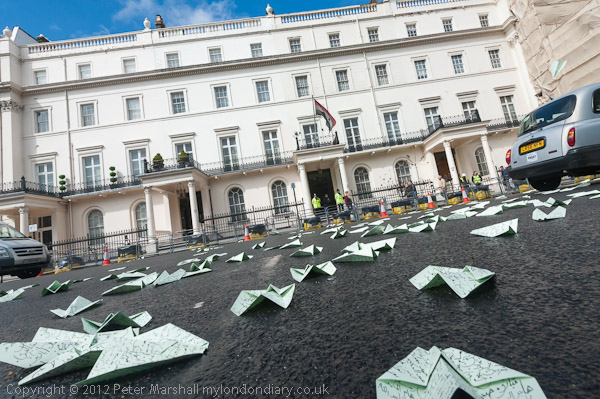
Most of the planes came to ground well short of the embassy
more pictures
In a peaceful protest against the killing of Syrian civilians by the Asad regime, the Free Syria Air Force (UK Division) launched a thousand paper airplanes bearing the names of the martyrs at the Syrian Embassy. There were no casualties.
The protest had been planned by the 'Free Syria Air Force', a London-based arts activist collective using stunts and satire to highlight human rights abuses by Bashar al-Assad's Syrian regime. They produced a sheet printed with the names of some of the many thousands killed by the brutal Asad dictatorship in hand-drawn Arabic calligraphy and folded a thousand of these to produce paper aeroplanes.
The Free Syria Air Force assembled in light rain in a street behind the embassy, where police questioned them about their intentions. They were told they could not launch the air strike from the pavement directly in front of the embassy but had to launch the attack from the protest pen facing it on the opposite side of the wide road around Belgrave Square.
At 1pm precisely the Air Force took up position and following a count-down launched the attack. There was a strong cross-wind and the most of the attack fleet were blown off course or landed short of the target, but the road was soon littered with paper planes, and some of those videoing and photographing the assault suffered mild collateral damage.
As the attack came to an end, the protesters released a cloud of black balloons
which shot quickly up into the air, but unfortunately the wind blew them away
from the Syrian embassy.
more pictures
EDL and UAF At Home Office
Marsham St, London. Tuesday 17 April 2012
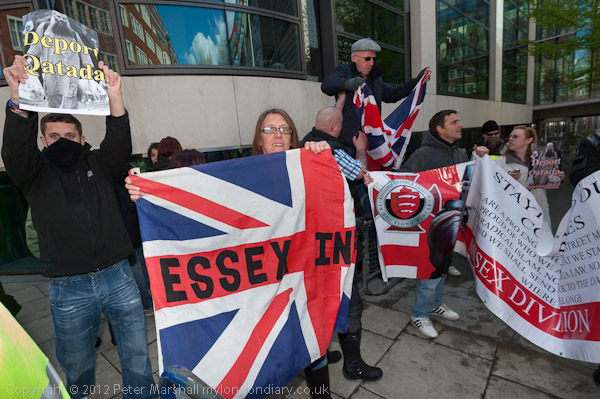
More of the EDL finally made it to the Home Office
more pictures
Unite Against Fascism protested together with PCS members outside the Home Office facing an EDL protest against the failure of our "cowardly, spineless government" to defy the European Court of Human Rights and deport Abu Qatada.
The EDL protest took place as it was announced that Home Secretary Theresa May intends to deport Abu Qatada expecting that the assurances she has received from the Jordan authorities will convince the Special Immigration Appeals Commission that these satisfy the requiremnts of the ECHR. However it seems likely that Qatada will appeal against this decision, thus delaying his deportation, and many believe that there is still no way he can receive a fair trial if he is deported. He was re-arrested this morning and the SIAC sat this afternoon and refused him bail. Later it emerged that the government had made something of a blunder, as Qatada's legal team filed a last-minute appeal with the ECHR - May had ordered the re-arrest before the actual deadline, a decision likely to lead to considerable further delays.
Abu Qatada has never been charged with any crime in the UK; there have been allegations by the British authorities that he has advised terrorists here, but he has never been tried for this. He was convicted in Jordan in his absence and on the basis of evidence obtained under torture for plotting attacks against tourists in that country for its millennium celebrations
Unite Against Fascism see the protest as a threat to the many black and ethnic minority Home Office staff and visitors by "the EDL’s racist and fascist thugs outside their workplace." The PCS general secretary Mark Serwotka said that his union was "also fully committed to opposing the EDL whose disgusting politics of hatred and division have no place in our communities. This [EDL] demonstration is clearly designed to do nothing more than intimidate and stir up racial tension, and it should be stopped." Theresa May was asked to ban it but refused to do so.
Home Office staff are not allowed to be members of far-right organisations such as the EDL. here were PCS members taking part in the counter protest with the Home Office branch banner, but PCS members working at the Home Office were also prohibited from taking part by their employer.
Around 50 UAF and PCS supporters had arrived by the time the EDL protest had been scheduled to start and a few more came later, but at that point there was a large pen with just one EDL supporter, with others rumoured to be gathering outside parliament. The UAF began a short rally, with speakers including Weyman Bennett and Martin Smith, which was still continuing ten muinutes later when another 20 or 30 EDL turned up; a smaller group came later still so that their numbers were then just a few fewer than the UAF.
For some time the two groups shouted loudly at each other, the UAF accusing the EDL of being racist and in particular Islamophobist and mentioning the links and e-mail exchanges between the EDL and Norwegian killer Anton Breivik. In return the EDL accused the UAF of supporting terrorists, of not being "British Any More" and made various libellous personal insults about Weyman Bennett and Martin Smith.
The UAF then drew back to the entrance area outside the Home Office and held
another short rally before ending their counter-protest as planned at 3pm.
more pictures
Binfield Walk
Binfield, Berkshire. Monday 16 April 2012
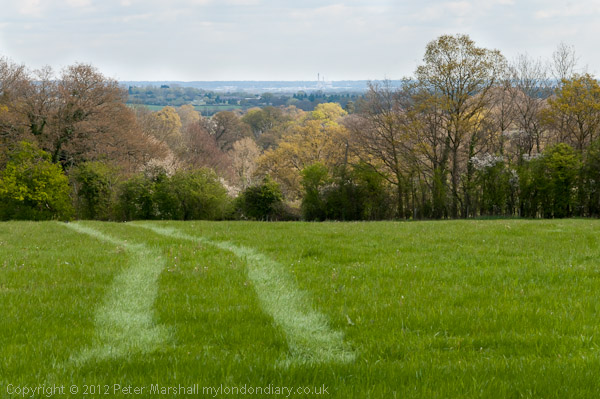
View across the Thames Valley
more pictures
Binfield is a wealthy village not too far from London, a quick drive on the motorway. George Orwell used its name in calling the town in his novel 'Coming Up For Air' 'Lower Binfield', a place clearly based on Henley-on-Thames a few miles north-west of Binfield. Slough is more or less the same distance to the east, but socially a million miles further away. Back in 1949, when nearby Bracknell was designated as a new town, Binfield must have been horrified. On the edge of Bracknell, it is still a place dotted with large houses with swimming pools and home to directors or former directors of major companies. Of course not everyone in Binfield is rich, but many are.
The Jack O'Newbury pub takes its name from one of of Tudor England's richest
men, John Winchcombe, who married the widow of the boss of the wool business
he worked at in Newbury, and made it into what has been described as the first
factory in England, amassing a vast fortune - cloth was at the time Englands
largest export - or more probably after his son, also John Winchcombe who
inherited and increased the family wealth. Fortunately the pub remains a village
pub in spirit and has not been turned into a gastro-pub or restuarant, but
serves good food at a decent price. And a couple of decent local beers I just
had to try after a short circular walk around the area.
more pictures
Gravesend Vaisakhi
Gravesend, Kent. Saturday 14 April
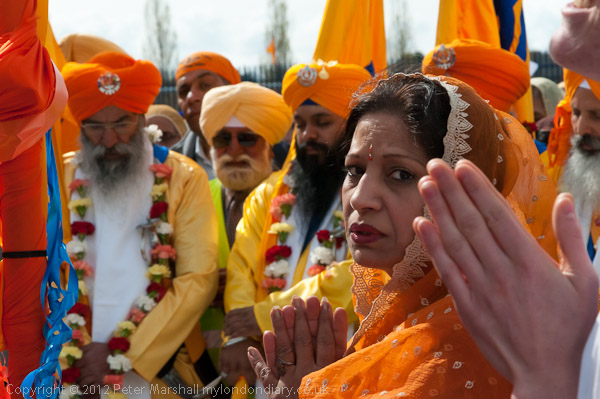
Prayers before the start of the procession around the
town (Nagar Kirtan)
more pictures
Thousands of Sikhs from Kent and S E London took part in a colourful Nagar Kirtan (procession) around central Gravesend to mark the Sikh festival of Vaisakhi with many other local residents lining the streets to watch. Gravesend, Kent, UK
At the start of the procession a large crowd gathered at the recently completed Guru Nanak Darbar Gurdwara and watched as the Guru Granth Sahib (Sikh Scriptures) were ceremonially carried out to be place inside a model of the Darbar Sahib (Golden Temple of Amritsar) on one of the floats at the head of the procession.
Ahead of this, at the very front of the procession was a flower-decorated lead car, followed by an open lorry carrying the large Nagara drum and its beaters. Behind this marched five Sikh men carrying the Sikh standard (Nishan Sahib) closely followed by five more with raised swords, the Panj Pyare, representing the five Sikhs baptised at Ananpundur in 1699 by the last living human Guru, Guru Gobind Singh Sahib, the founding of the 'Khalsa'.
Behind the Guru Granth Sahib came the walking congregation (Sangat) led by Punjabi School children, then the women and after them the men, along with various vehicles carrying the elderly. After the religious Vaisakhi procession were lorries with cultural, social and sports groups, including Bhangra groups the Guru Nanak Football Club and children from local primary schools.
Slowly the procession made its way through the main shopping streets of Gravesend, with many small groups of Sikhs on the way handing out free vegetarian food and drink. I enjoyed some delicious vegetable curry with a strong mint flavour as well as some very sweet chai and a couple of vegetable samosas, but there were also plenty of treats for the children, lollipops, soft drinks and sweets.
There was a large crowd waiting for the procession in the area around the Ravidas Gurdwara, a rather smaller building in a side street, where there were some very busy stalls serving free food and a shoulder to shoulder line of people handing out packets of crisps, soft drinks, and other treats - and even at least one handing out more healthy bananas.
I watched the end of the procession go past the civic centre on its way back
to the Gurdwara before catching a train home. The Vaisakhi celebrations at
Gravesend continue tomorrow with the main religious service in the Gurdwara.
more pictures
Olympic Site Revisited
Stratford Marsh, Friday 13 April 2012
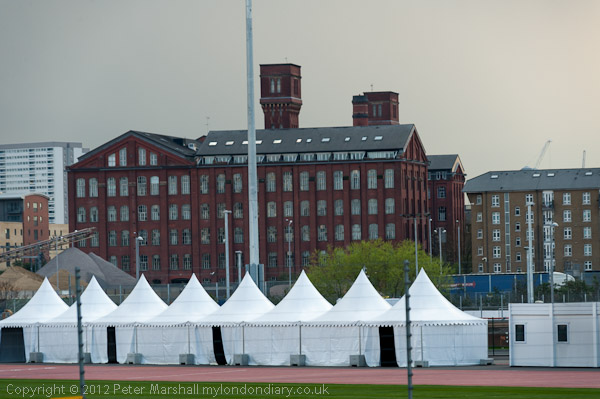
The Olympic Practice area has a medieval look, overlooked
by the former match factory, which will have missiles stationed on it during
the games
more pictures
One of my photographer friends had wanted to be shown around the outside
of the Olympic area as he needed a couple of related pictures to go with an
article which clearly had the Olympic branding. I walked along with him and
made a few panoramas as well as some normal format pictures. The light was
beginning to look a little threatening to the west as we came to the View
Tube or perhaps it was the pollution over central London which gave this image
its sullen sky and dark mood while the panoramas of the stadium look bright
and sunny.
more pictures
Gasworks Dock Revived
Cody Dock & Bow Creek, London. Friday 13 April 2012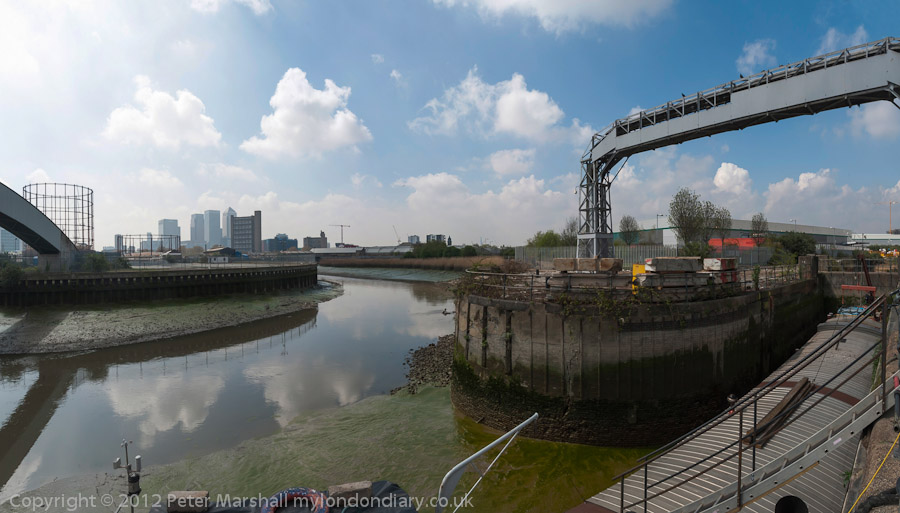
Bow Creek and the entrance to Cody Dock - a roughly
120 degree panoramic view.
more pictures
Around 1870, when the Imperial Gas Company were building their works at Bromley by Bow they built a dock on Bow Creek to bring in the coal to the works and take out coke and possibly other products. The location of the works was perhaps not particularly well-chosen, as coal could only be brought up the tidal creek for a few hours on each high tide. The orginal dock was around 1000 ft long and 100 ft wide, and the large-scale OS maps show a rather narrower entrance of roughly 20-25 ft with a single dock gate and a swing bridge across it.
The gas works ceased production in the early 1960s, and the site is now a business park, but perhaps surprisingly the dock - or at least part of it is still there. Maps have gone metric, but the dock is still around the same width of 30m, but the dock was reduced to around a third of its original length at 110m, still a sizeable body of water. It appears to have been retained as part of a drainage scheme for the area, although it probably no longer operates as such, and was given a solid barrier across the entrance in place of a gate, with a fixed walkway across. There is also a substantial high cable bridge across near the mouth of the entrance.
A few years ago Simon Myers came up Bow Creek in a boat, saw the entrance and decided to find out more about the disused dock. As I found a little later, there were plans for a path from the Olympic area to the Thames and the dock was an obstacle, in particular because of problems of ownership. The planners of the so-called 'Fatwalk' had decided to avoid it with a million pound footbridge across Bow Creek just above the site, but the money ran out before much of the Fatwalk could be completed, its premature end at a fence around the dock.
Myers set up the Gasworks Dock Partnership as a social enterprise in November 2009 and it was registered as a charity in 2001 to "act as a vehicle for community led regeneration and nurtures public engagement in the revitalisation of our waterways." Based at Cody Dock it has already set up a Docklands Community Boat and is busy developing the 2.5 acre site, and has now more or less cleared the many tons of rubbish and rubble. The GDP hopes to open up the dock to provide mooring for a number of barges, both for living in and visitor moorings and to provide a wooden bascule bridge across the dock entrance to carry the Fatwalk across, which would join the existing section from beside Twelvetrees Bridge to a isolated section only currently accessible to those working on the neighbouring industrial estate. A short section along currently unused riverbank next to a recycling area could then extend the path to join up with the existing path and bridge south of the East India Dock Road (where there is also a riverside path completed around 20 years ago but never opened to the public with an entrance from Canning Town station) and allow walkers to reach the Thames at East India Dock and Trinity Buoy Wharf.
The dock itself is brick lined and was presumably dredged before it was isolated from the river as there is only a few inches of mud on its bottom. The plan is to remove the current barrier and to have a low sill across the entrance which would retain water in it at low tide but allow boats to come in and out around high tides, the only times when navigation is possible in Bow Creek. It has a small reedbed at one end and is a haven for wild life, with many bird species living there or visiting. I didn't see a kingfisher, but they are there most days.
Other developments planned for the Cody Dock site include Visitor centre & café, an exhibition space, an industrial heritage archive and museum, affordable studio and workshop space and dry dock facilities.
This is an exciting community development that aims to give the public access to more of the Lower Lea and to see its varied wildlife as well as celebrating its industrial heritage. It will also set up a lively community based arts and creative industries quarter which will stimulate creative enterprise in the area, and will support a wide range of arts, cultural and educational programs. It is a great example of a project that has arisen out of the heritage and potential of the area rather than something essentially alien imposed by outside bodies, one that will enrich and grow the area rather than distort its priorities. It comes at a time when a new DLR station, Star Lane, just a few minutes walk away has greatly increased the ease of access to the area.
Cody Dock has come a long way - particularly since Myers was warned it would
be impossible to do anything there when he started, and the site should be
open to the public this summer. But it needs money and volunteers to realise
its plans and has recently launched an appeal on Spacehive,
aiming to raise £140,276 by 6 June.
more pictures
Class War Snack Attack
King's Road, Chelsea, London. Wednesday 11 April 2012
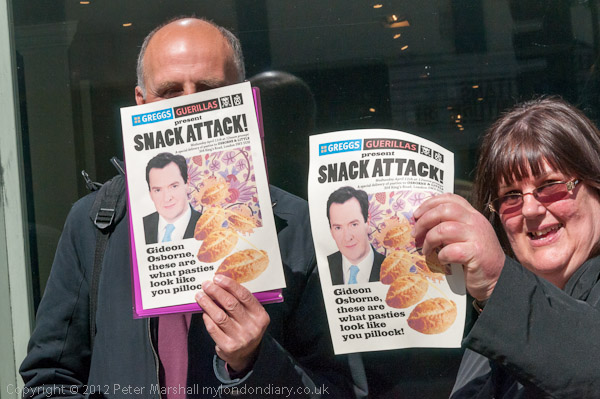
Greggs Guerillas present Snack Attack outside Osborne
& Little interior décor shop in Chelsea
more pictures
Ten people came for a peaceful 'snack attack' protest against the 'pasty tax' carrying pasties, pies and posters outside Chancellor George Osborne's family interior décor shop in the Kings Road Chelsea.
The highlight of the protest was the late arrival from the Midlands (where pies are a serious business) of a couple of protesters, one dressed as a peasant girl, holding a wooden placard 'The Peasants Are Revolting' and carrying a large wicker basket full of envelopes bearing the text 'Tasty Pasties Not Pasty Tories' under a stapled on picture of George Osborne. Inside was a folded A4 sheet headed 'The Angry Brigade Communique #1', a long tirade of statements each starting with the word F**k and expressing contempt for the Tories, Lib Dems and various named members of both parties, the Banks, Goldman Sachs and almost every other institution including the IRA, UDA, Taliban, Al Queda, Religion, Theme Pubs, Gastro Bars, The Daily Mail, the CBI, IoD, TUC, the cuts, New Labour, Ed Miliband, The Olympics, Public Schools, The BNP, EDL, trots and fascists and a whole lot more, with a few amusing comments thrown in.
Earlier, anarchist blogger Ian Bone had turned up with a few friends and some pasties, pies and posters, and held them up outside the front of the shop for photographs. The poster for the 'Snack Attack' protest by 'Greggs Guerillas' had promised that 'Pies will be delivered like an Arab Shoe' and showed a pie and a pasty winging their way towards Osborne's head, his torso below a target with a pie splatting on it and the text 'Throw Your Pies To Win A Prize!!!' but in the event the pies were not even unwrapped - although the story night have been very different had the man himself put in an appearance.
In the event the shop remained open, though there were no customers around and the police officers standing inside might well have deterred any had they come. The protesters prefer to call Osborne by his original first name of Gideon, which he decided to change at the age of 13 to George, which he says made his life easier at St Paul's School perhaps beacuse it made him appear less privileged. His trust fund, estimated to be worth around £4 million, owns 15% of the family firm of Osborne & Little outside which the protest was taking place.
A police officer standing outside engaged the protesters in friendly conversation and told them that if they wished to protest for longer than a few minutes they would have to do so from the opposite side of the road. Rather than do so, the group decided to adjourn to the nearby Cadogan Arms, and I was thinking of joining them when the two further protesters arrived. The protesters then returned to protest for a few minutes longer.
Bakers groups and others are also planning to hold protests, although in London these are expected to take place opposite Downing St. Feelings are running particularly high in Cornwall where pasty production is a major industry, employing around 13,000 people in making Cornish Pasties (which have Protected Geographical Indication statue from the EU) and the 20% VAT on hot baked goods (currently exempt as foodstuffs) is likely to have a drastic effect on employment in the region. The Facebook 'Say No To the Pasty Tax' group currently has around 6,500 members.
As well as photographing in the dock, I walked away from it along the 'Fatwalk'
and took pictures of Bow Creek before catching a bus from the 'Gas Museum'
stop close the the war memorial and still in use gas holder site. The bus
stop retains the name although the handsome former museum building is now
private offices.
more pictures
Roma Nation Day Of Resistance
Hyde Park Corner - Hungarian Embassy, London. Sun 8 April 2012
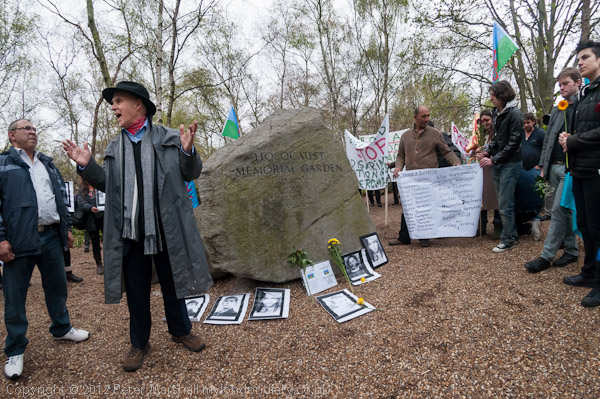
Grattan Puxon speaking in the Holocaust Memorial Garden
in Hyde Park
more pictures
Roma, Travellers and their supporters marched on Roma Nation Day to protest at the embassies of some of the European states which systematically oppress Roma and Travellers and on to the Department for Communities and Local Government.
Roma Nation Day is marked by many thousands of Travellers, Roma and Gypsies around the world, although this year it fell on Easter Sunday which perhaps made attending today's protest a problem for the many of them who are devout Catholics. April 8 was chosen for the day as it was the date of the first World Roma Congress which was held in the UK in 1971. Leading today's protest was Grattan Puxon who was one of the organisers of that congress.
The London event was organised by the Traveller Solidarity Network, formed at the time of the eviction of the Dale Farm eviction. Alice McGuire, a member of the network and organiser of the demo said, "Dale Farm made many in the UK sit up and notice the discrimination Travellers face. Sadly there are Dale Farms happening up and down the country and across Europe every week. This government is making things worse rather than better and we must all stand together to stop this from happening."
Among the roughly one hundred at the protest were some of those involved at Dale Farm, a strong group of Bulgarian Roma from Tottenham and people from various organisations supporting human rights, including Amnesty International who welcomed the event as highlighting the persecution and discrimination faced by these communities. Last week they published a report showing that the life expectancy of a male Traveller in Ireland is 15 years lower than the national average, and the UK Government also published a report showing the large inequalities Gypsies and Travellers face here.
In many countries things are tougher still, with the rise of neo-fascists and increasingly open discrimination and verbal and physical attacks. One poster listed the names of over 20 Roma murdered in Bulgaria, where there have been widespread anti-Roma activities.
The march started with a visit to the Holocaust Memorial in Hyde Park. Gypsies - Roma and Sinti - had been the subject of discriminatory laws in Germany even before the rise of Hitler, and compulsory sterilisation and arrests of them started in 1933. In 1935 they were included in the laws against Jews and in 1938 many were put into concentration camps. When the war started they were systematically deported and killed in much the same way as the Jews. There are no exact figures for the number murdered, but it is generally thought to be around 500,000, although the total for the whole of the Nazi empire may have been considerably higher, with almost total extermination of the Roma communities in some countries and a more selective policy in others. The genocide of the Roma was formally recognised by West Germany in 1982
At the memorial there were short speeches by Puxon and some of the other leaders, and flowers were laid on pictures of some of the victims of the Nazis and a card which read 'Rest in Peace the 500,000 Roma murdered by Hitler and those who have died at the hands of today's neo-fascists.
The protesters stopped briefly for a picnic in Hyde Park before going on to protest at the nearby French embassy, in particular against President Sarkozy's recent attack on the Roma community as a "source of criminality" and the wholesale deportations. From there it was a lengthy walk to the Bulgarian embassy in Kensington, made more pleasant by the loud Tzigane music on a bicycle mounted sound system.
I left the marchers there and rejoined them at Eaton Place where the Hungarian Embassy faces the Italian Consulate across the road. There was a short rally there where a member of Amnesty talked about the rising discrimination here and in Romania with fire-bomb attacks on Roma settlements by far-right groups being largely ignored by the authorities. Roma also face discrimination in Italy, and a letter to the Italian ambassador stated:
"Every day in Italy Roma civil society continues to suffer from a policy of forced evictions, violence, racism, deportations, humiliations, illegal expulsions of EU citizens."
The march was continuing to the offices of Eric Pickles, the Department for Communities and Local Government in part responsible for the Dale Farm Evictions, which it is hard not to see as largely driven by racist attitudes. Dale Farm is no isolated case, with planning applications involving Roma and Travellers being turned down at a far higher level than those for other groups.
In a press release, Grattan Puxon said, "It’s great to see
different communities, from Dale Farm to Bulgaria, coming together to say
enough is enough. Life for Gypsies, Roma and Travellers in the UK and around
the world is getting worse not better. The injustice of Dale Farm is sadly
just the tip of the iceberg".
more pictures
International Pillow Fight Day
Trafalgar Square, London. Sat 7 April 2012
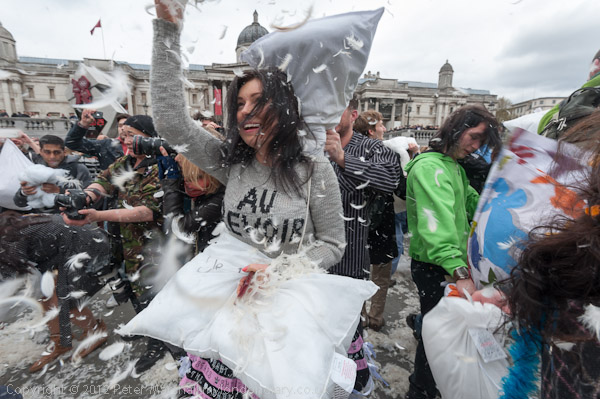 Feathers
soon began to fly in the square
Feathers
soon began to fly in the square
more pictures
Over a hundred people armed with pillows turned up in Trafalgar Square on the dot at 3pm to take part in a fierce pillow fight, if not to the death at least to exhaustion over the next 30 minutes of International Pillow Fight Day.
London was just one of the 111 cities around the world in which massive pillow fights inspired by the urban playground movement were taking place. There were fights in cities from Amsterdam to Zürich, with the majority being in the USA, but they were also in virtually every European country, as well as in Canada, Greenland, Turkey, Bahrain, South America, Cape Town, Australia, Hong Kong and China.
The fight was supposed to follow nine simple rules:
0) First and foremost: no violence - DO NOT HURT ANYONE!
1) DON'T LEAVE YOUR PILLOWS BEHIND
2) Soft pillows only (and no extra objects in the pillows)
3) Swing lightly (many people will be swinging at once)
4) Do not swing at anyone without a pillow or holding a camera
5) Remove your glasses before you jump in
6) NO FEATHERS, let's not make a mess
7) Be cool and hide your pillows until the start signal at 3pm
8) Wear pyjamas or whatever you sleep in (no ugly-naked-guys!)
but most of them were soon broken in the heat of the fight, although many of those who hit me apologised afterwards. But there were certainly some hefty swings and some of the pillows were not quite feather-light, while others burst to scatter feathers widely, and by the end of the event there was a good layer of feathers over the whole area, with many pillows that had split or been lost abandoned with them.
The fight was half an hour of glorious chaos as people of all ages - though mainly in their teens and twenties - rushed around attacking anyone with a pillow. Occasionally a cry went out to attack the panda, or the guy in stripes or spiderman or one of the others in identifiable costumes, but generally everyone made random attacks on whoever was within pillow range.
The council's cleaners began to move in after 20 minutes, puring buckets
of water from the fountains to damp down the feathers and sweeping them away
at one side, but the fight continued in the remainder of the square, with
a few continuing after the signal was given to stop at 3.30pm.
more pictures
Syrians Continue Protest Against Asad
Downing St, Whitehall, London. Sat 7 April 2012
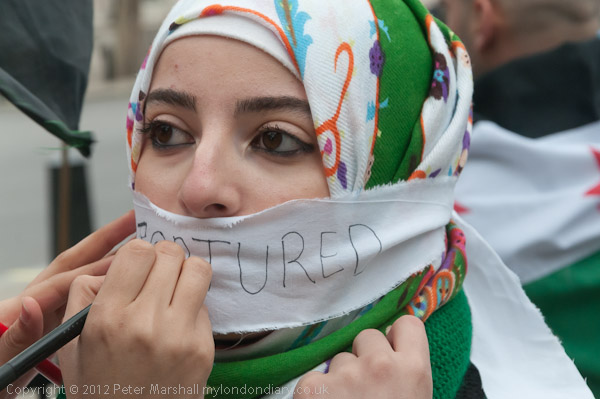
A young woman has the word 'TORTURED' written on a bandage
across her mouth
more pictures
Free Syria Supporters protested again opposite Downing Street against the continuing killing, torture, imprisonment and abductions of their relatives by the Asad regime, calling for greater action by William Hague and the UK government.
What affected me about today's protest by the Syrians were the many among those protesting whose own family members were suffering in Syria. They were not protesting against some abstract violations of human rights and human life. Many held up placards 'For My Sister', 'For My Mum' and for some at least of those wearing gags with the words 'Freedom' or 'Tortured' it was there own family who was tortured or missing or held in jail. Some held family snapshots, blown up to A4, and others were taped to the railings along with lists of names, and roses dedicated to the missing and dead.
Many others held posters calling for the release of 24 year old Syrian woman human rights activist Noura Aljizawi, a gifted student missing since 28 March. As well as working in hospitals and to support women and children she was also a a writer for Hurriyat, the first underground Syrian revolution paper.
On a pillar behind and on the leaflets handed out were the grim statistics.
12,460 Syrians killed since March 2011; 65,000 innocent Syrians are missing;
882 children and babies murdered, 773 women slaughtered; 212,000 men women
and children are detained; 30,627 refugees fled in fear of their lives. And
the numbers are still rising.
more pictures
World Health Day: Lansley's Bill
Dept of Health, Whitehall, London. Sat 7 April 2012
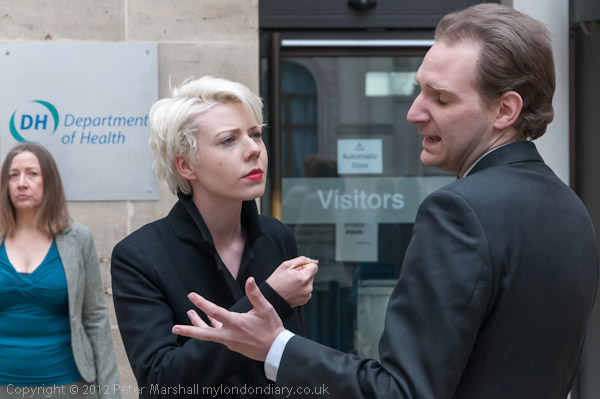
Lansley's Bill - Lansley lies to the media in the play
performed outside the Dept of Health
more pictures
Although the Act to privatise the NHS has passed, campaigners still trying to save the NHS as a free and universal service protested on World Health Day outside the Department of Health in Whitehall with a performance of the play 'Lansley's Bill'.
The protest began with a speech by Gay Lee, a NHS palliative care nurse and campaigner to save the NHS, who outlined how the Act will allow private companies to take over the health service, converting it to an insurance-based healthcare system that will provide high-cost medical services for those who can afford it while retaining only a basic provision for others. She outlined the various organisations that are fighting to keep a free and universal service and how we can support them.
Her short talk was followed by a performance of the play 'Lansley's Bill' by Mike Hart, directed by Hugh Allison and performed by Martin Brady, Hayley Chilvers, Maxine Howard, Linda Large, Rosie Raven, James Riley and Jodyanne Richardson.
This fictional play is based on the facts of the planning by McKinzey Consulting and the Tories which led to the Lansley Bill, a bundle of Tory lies which opens up healthcare to the market under the misleading mantras of 'choice' and 'efficiency'. As an actor heckler shouted, when we are ill what we want is effective treatment, not choice, and the experience from the USA and elsewhere shows that providing healthcare by the market is around 20% more expensive than a properly managed collective system which does not need to make profits for shareholders.
The play highlights the problem of cleaner Mrs Mopczinski, who finds that when she needs the help of the new NHS she is told to wait - until she dies. The play makes the point effectively and entertainly that "you have a choice. You can fight for the NHS, become rich, or you can make sure you are never ill. The least worst case is to get out there and fight.
The protest had not been widely advertised and the audience for its first
performance outside the Department of Health was small but very appreciative.
This is a play that deserves to be seen by a wider audience.
more pictures
Christians Celebrate Good Friday
Staines, Middx. Friday 6 April 2012
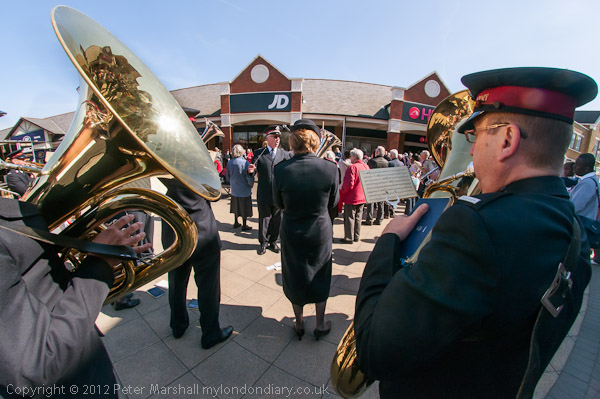
The Salvation Army Band played for the service which
took place in the Two Rivers shopping centre
more pictures
Christians in Staines on the outskirts of London came together on Good Friday to witness their faith with a march and an open-air service in the town's shopping centre, giving out hot cross buns.
Around 200 Christians from various denominations marched through Staines Town Centre led by a man carrying a large wood cross, followed by leaders of the various churches in the area and the Salvation Army Band and then a crowd of worshippers. They gave out free hot cross buns and held a service in the Two Rivers shopping centre in the middle of the town.
The procession of witness here was typical of many across the country, although organising such events has become more difficult as more of our town centres become privatised and some towns have had to give up processions because of over-stringent requirements for insurance.
Around 400 hot cross buns were given out free to shoppers, along with a serviette
explaining the significance of the cross on the buns.
more pictures
Twickenham & Richmond
LB Richmond. Sunday 1 April 2012
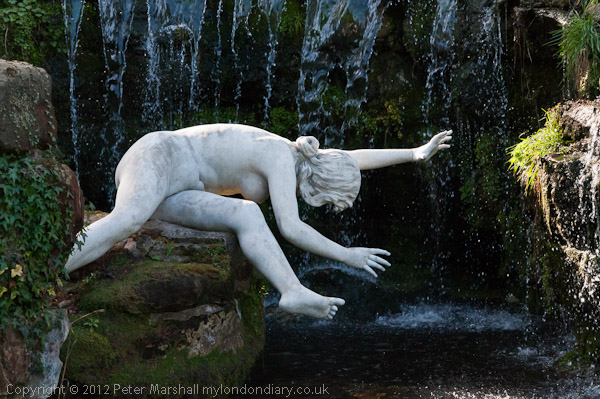
Statuary in Riverside Gardens at Twickenham
more pictures
We had German visitors staying with us and took them for a walk from Twickenham
along by the River Thames and up Richmond Hill to King Henry's mound in Richmond
Park. It was a clear day and from here we could see both St Paul's Cathedral
and Windsor Castle. The view to St Pauls is one of those that is protected.
more pictures
top of page
All pictures on this section of the site are Copyright © Peter Marshall 2012; to buy prints or for permission to reproduce pictures or to comment on this site, or for any other questions, contact me.

